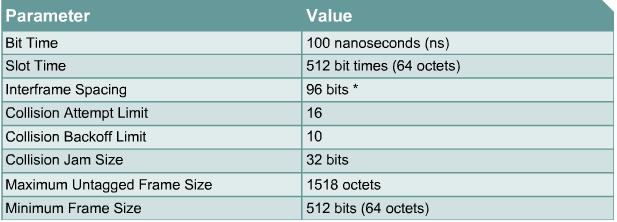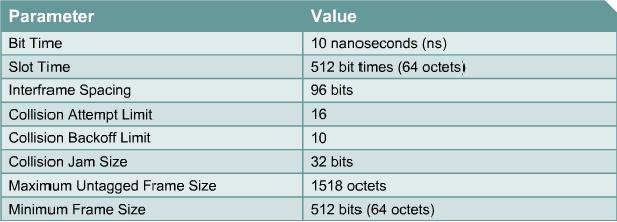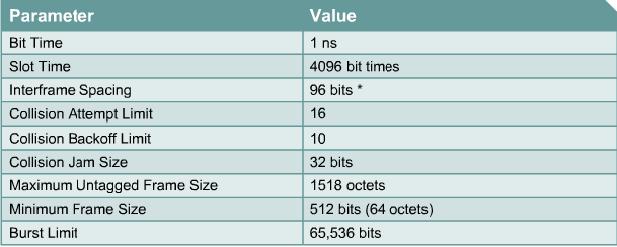Ethernet Technologies
From Mycomputer Notes
(→100Mbps Ethernet) |
|||
| (32 intermediate revisions not shown) | |||
| Line 9: | Line 9: | ||
| width="9%" | | | width="9%" | | ||
|- | |- | ||
| - | | width="30%" bgcolor="#CCFFCC" | <font face="Garamond">50-ohm coaxial | + | | width="30%" bgcolor="#CCFFCC" | <font face="Garamond">50-ohm coaxial cable</font> |
| - | + | | width="39%" bgcolor="#CCFFCC" | <font face="Garamond"><b>10 BASE2</b>(Ethernet,Thinnet)</font> | |
| - | | width="39%" bgcolor="#CCFFCC" | <font face="Garamond"><b>10 BASE2</b> | + | |
| - | + | ||
| width="16%" bgcolor="#CCFFCC" | <font face="Garamond">10 Mbps</font> | | width="16%" bgcolor="#CCFFCC" | <font face="Garamond">10 Mbps</font> | ||
| width="9%" bgcolor="#CCFFCC" | <font face="Garamond">185 m</font> | | width="9%" bgcolor="#CCFFCC" | <font face="Garamond">185 m</font> | ||
| Line 22: | Line 20: | ||
|- | |- | ||
| width="30%" bgcolor="#CCFFCC" | <font face="Garamond">Category 5 UTP</font> | | width="30%" bgcolor="#CCFFCC" | <font face="Garamond">Category 5 UTP</font> | ||
| - | | width="39%" bgcolor="#CCFFCC" | <font face="Garamond"><b>10 BASE-T</b> | + | | width="39%" bgcolor="#CCFFCC" | <font face="Garamond"><b>10 BASE-T</b>(Ethernet)</font> |
| - | + | ||
| width="16%" bgcolor="#CCFFCC" | <font face="Garamond">10 Mbps</font> | | width="16%" bgcolor="#CCFFCC" | <font face="Garamond">10 Mbps</font> | ||
| width="9%" bgcolor="#CCFFCC" | <font face="Garamond">100 m</font> | | width="9%" bgcolor="#CCFFCC" | <font face="Garamond">100 m</font> | ||
| Line 33: | Line 30: | ||
|- | |- | ||
| width="30%" bgcolor="#CCFFCC" | <font face="Garamond">Category 5 UTP</font> | | width="30%" bgcolor="#CCFFCC" | <font face="Garamond">Category 5 UTP</font> | ||
| - | | width="39%" bgcolor="#CCFFCC" | <font face="Garamond"><b>1000 BASE-TX</b> | + | | width="39%" bgcolor="#CCFFCC" | <font face="Garamond"><b>1000 BASE-TX</b>(Ethernet)</font> |
| - | + | ||
| width="16%" bgcolor="#CCFFCC" | <font face="Garamond">1000 Mbps</font> | | width="16%" bgcolor="#CCFFCC" | <font face="Garamond">1000 Mbps</font> | ||
| width="9%" bgcolor="#CCFFCC" | <font face="Garamond">100 m</font> | | width="9%" bgcolor="#CCFFCC" | <font face="Garamond">100 m</font> | ||
| Line 43: | Line 39: | ||
| width="9%" | <font face="Garamond">2000 m</font> | | width="9%" | <font face="Garamond">2000 m</font> | ||
|- | |- | ||
| - | | width="30%" bgcolor="#CCFFCC" | <font face="Garamond">Multimode | + | | width="30%" bgcolor="#CCFFCC" | <font face="Garamond">Multimode optical fiber</font> |
| - | + | | width="39%" bgcolor="#CCFFCC" | <font face="Garamond"><b>1000 BASE-SX</b>(62.5/125 um)</font> | |
| - | | width="39%" bgcolor="#CCFFCC" | <font face="Garamond"><b>1000 BASE-SX</b> | + | |
| - | + | ||
| width="16%" bgcolor="#CCFFCC" | <font face="Garamond">1000 Mbps</font> | | width="16%" bgcolor="#CCFFCC" | <font face="Garamond">1000 Mbps</font> | ||
| width="9%" bgcolor="#CCFFCC" | <font face="Garamond">220 m</font> | | width="9%" bgcolor="#CCFFCC" | <font face="Garamond">220 m</font> | ||
|- | |- | ||
| width="30%" | <font face="Garamond">Multimode optical fiber</font> | | width="30%" | <font face="Garamond">Multimode optical fiber</font> | ||
| - | | width="39%" | <font face="Garamond"><b>1000 BASE-SX</b> ( | + | | width="39%" | <font face="Garamond"><b>1000 BASE-SX</b> (50/125 um)</font> |
| width="16%" | <font face="Garamond">1000 Mbps</font> | | width="16%" | <font face="Garamond">1000 Mbps</font> | ||
| width="9%" | <font face="Garamond">550 m</font> | | width="9%" | <font face="Garamond">550 m</font> | ||
|- | |- | ||
| width="30%" bgcolor="#CCFFCC" | <font face="Garamond">Single Mode optical fiber</font> | | width="30%" bgcolor="#CCFFCC" | <font face="Garamond">Single Mode optical fiber</font> | ||
| - | | width="39%" bgcolor="#CCFFCC" | <font face="Garamond"><b>1000 BASE-LX</b> | + | | width="39%" bgcolor="#CCFFCC" | <font face="Garamond"><b>1000 BASE-LX</b>(9/125 um)</font> |
| - | + | ||
| width="16%" bgcolor="#CCFFCC" | <font face="Garamond">1000 Mbps</font> | | width="16%" bgcolor="#CCFFCC" | <font face="Garamond">1000 Mbps</font> | ||
| width="9%" bgcolor="#CCFFCC" | <font face="Garamond">5000 m</font> | | width="9%" bgcolor="#CCFFCC" | <font face="Garamond">5000 m</font> | ||
|} | |} | ||
| + | |||
| + | =10Mbps Ethernet= | ||
| + | ''10BASE5, 10BASE2, 10BASE-T '' implementations of Ethernet are considered legacy implementations. Four things are common among legacy Ehternet: Timing parameters, Frame format, Transmission porcess, Basic design rule. | ||
| + | The transmission process of legacy Ethernet is identical until the lower part of the OSI Physical Layer | ||
| + | As the frame passes from the MAC sublayer to the physical layer, futher processes occur before the bits are placed on the medium from the physical layer. One known process at this level is the signal quality error ('''SQE''') | ||
| + | All 10-Mbps forms of Ethernet take octets received from the MAC sublayer and perform a process called '''line encoding'''. This process describe how the bits actually are signaled on the wire. | ||
| + | [[Image:10Mbps_Ethernet.JPG |frame|left|Legacy Ethernet Operations common to 10BASE5, 10BASE2, 10BASE-T ]]<br><br><br><br><br><br><br><br><br><br><br><br><br><br> | ||
| + | |||
==10BASE5== | ==10BASE5== | ||
| Line 85: | Line 86: | ||
*Because all the computers were attached to a single cable this type of design was a bus designed. | *Because all the computers were attached to a single cable this type of design was a bus designed. | ||
==10BASE-T== | ==10BASE-T== | ||
| + | *Included in the (802.3i) standard in 1990 | ||
| + | *Plugged into a central connection, hub or switch, that contained the shared bus. | ||
*Originally half duplex protocol, full duplex feature was added later. | *Originally half duplex protocol, full duplex feature was added later. | ||
| - | * | + | *10Base-T uses Cat 3, Cat 5, Cat 5e over UTP cable |
| + | *Can be runned with T568A or T568B cable pinout arrangement. | ||
*10Base-Network are alive with a Link Pulse. | *10Base-Network are alive with a Link Pulse. | ||
| + | =100Mbps Ethernet= | ||
| + | |||
| + | ;100Mbps Ethernet: Also knows as Fast Ethernet is a series of technologies including 100Base-TX & 100Mbps-FX. | ||
| + | Commonalities between these two technologies and their difference: | ||
| + | *Timing parameters | ||
| + | *Frame format | ||
| + | *Parts of the transmission process. | ||
| + | |||
| + | Fast Ethernet increase speed of the transmission but it requires extra requirements. The bits being sent get shorter in duration and they are sent more frequently. The tranmission requires more careful '''timing''', trasmission needs frequencines closer to bandwith limitations and it becomes more susceptible to noise. | ||
| + | [[Image:100Mbps_Ethernet.JPG |frame|left|Ethernet Operations for 100 Mbps]] | ||
| + | |||
| + | |||
| + | <BR><BR><BR><BR><BR><BR><BR><BR><BR><BR><BR><BR><BR><BR><BR> | ||
| + | ==100BASE-TX== | ||
| + | *Copper UTP based | ||
| + | TEXT TO ADD | ||
| + | |||
| + | |||
| + | |||
| + | TEXT TO ADD | ||
| - | |||
| - | |||
==100 BASE-FX== | ==100 BASE-FX== | ||
| + | Introduced, as part of the 802.3u-1995, at the same time as the copper version of Fast Ethernet. | ||
| + | *Multimode optical fiber-based | ||
| + | *Introduced for backbones applications(between floor & buildings) | ||
| + | *Alternative to the then popular FDDI | ||
| + | *Signals are LED pulses on multimode optical fiber. | ||
| + | *Gigabit Ethernet (copper) is responsible for the lack of adoption on 100BASE-FX | ||
| + | *100BASE FX is synchronous. | ||
| + | |||
| + | =1000Mbps Ethernet= | ||
| + | [[Image:1000Mbps_Ethernet.JPG |frame|left|Gigabit Ethernet Operations]] | ||
| + | |||
| + | |||
| + | |||
| + | |||
| + | ==1000 BASE-TX== | ||
==1000 BASE-SX== | ==1000 BASE-SX== | ||
| - | + | ==1000 BASE-LX== | |
| - | + | ||
Current revision as of 20:40, 6 April 2006
| MEDIUM | Maximum Theoretical Bandwith | Maximum Physical Distance | |
| 50-ohm coaxial cable | 10 BASE2(Ethernet,Thinnet) | 10 Mbps | 185 m |
| 50-ohm coaxial cable | 10 BASE5 (Ethernet,Thicknet) | 10 Mbps | 500 m |
| Category 5 UTP | 10 BASE-T(Ethernet) | 10 Mbps | 100 m |
| Category 5 UTP | 100 BASE-TX (Ethernet) | 100 Mbps | 100 m |
| Category 5 UTP | 1000 BASE-TX(Ethernet) | 1000 Mbps | 100 m |
| Multimode optical fiber | 100 BASE-FX (62.5/125 um) | 100 Mbps | 2000 m |
| Multimode optical fiber | 1000 BASE-SX(62.5/125 um) | 1000 Mbps | 220 m |
| Multimode optical fiber | 1000 BASE-SX (50/125 um) | 1000 Mbps | 550 m |
| Single Mode optical fiber | 1000 BASE-LX(9/125 um) | 1000 Mbps | 5000 m |
Contents |
[edit] 10Mbps Ethernet
10BASE5, 10BASE2, 10BASE-T implementations of Ethernet are considered legacy implementations. Four things are common among legacy Ehternet: Timing parameters, Frame format, Transmission porcess, Basic design rule. The transmission process of legacy Ethernet is identical until the lower part of the OSI Physical Layer As the frame passes from the MAC sublayer to the physical layer, futher processes occur before the bits are placed on the medium from the physical layer. One known process at this level is the signal quality error (SQE) All 10-Mbps forms of Ethernet take octets received from the MAC sublayer and perform a process called line encoding. This process describe how the bits actually are signaled on the wire.
[edit] 10BASE5
10BASE5 transmitted 10Mbps over a single thick coaxial cables thus giving the name of Thicknet
- First medium used for Ethernet
- Part of the original 802.3 standard
- Inexpensive and do not required configuration(no needs for hubs to extend the length of systems)
- Technologoy is very sensitive to signal reflections
- Cable-dependent across the whole collision domain and it represents a large single point of failure.
- 10BASE5 uses Manchester-encoded signals.
- Other specifications or limitations are:
- Only one station can transmit at a time (collision will occur)
- 10Base5 can run only in half-duplex mode (subject to CSMA/CD rules)
- 100 stations & including repeaters can exist on any individual 10Base5 segment.
[edit] 10BASE2
Introduced in 1985 and because of its smaller size, lighter wight, and greater flexibility ,it was easier to install than 10BASE5 because of its thinner cable is was known as Thinnet.
- Also know as 802.3a
- Still exist in legacy networks
- Low cost and lack of need for hubs are attractive
- The computer were linked together bu a series of coaxial cables. These cables were attached by BNC connectors to a t-Shape connector on the NIC.
- Because all the computers were attached to a single cable this type of design was a bus designed.
[edit] 10BASE-T
- Included in the (802.3i) standard in 1990
- Plugged into a central connection, hub or switch, that contained the shared bus.
- Originally half duplex protocol, full duplex feature was added later.
- 10Base-T uses Cat 3, Cat 5, Cat 5e over UTP cable
- Can be runned with T568A or T568B cable pinout arrangement.
- 10Base-Network are alive with a Link Pulse.
[edit] 100Mbps Ethernet
- 100Mbps Ethernet
- Also knows as Fast Ethernet is a series of technologies including 100Base-TX & 100Mbps-FX.
Commonalities between these two technologies and their difference:
- Timing parameters
- Frame format
- Parts of the transmission process.
Fast Ethernet increase speed of the transmission but it requires extra requirements. The bits being sent get shorter in duration and they are sent more frequently. The tranmission requires more careful timing, trasmission needs frequencines closer to bandwith limitations and it becomes more susceptible to noise.
[edit] 100BASE-TX
- Copper UTP based
TEXT TO ADD
TEXT TO ADD
[edit] 100 BASE-FX
Introduced, as part of the 802.3u-1995, at the same time as the copper version of Fast Ethernet.
- Multimode optical fiber-based
- Introduced for backbones applications(between floor & buildings)
- Alternative to the then popular FDDI
- Signals are LED pulses on multimode optical fiber.
- Gigabit Ethernet (copper) is responsible for the lack of adoption on 100BASE-FX
- 100BASE FX is synchronous.
[edit] 1000Mbps Ethernet



